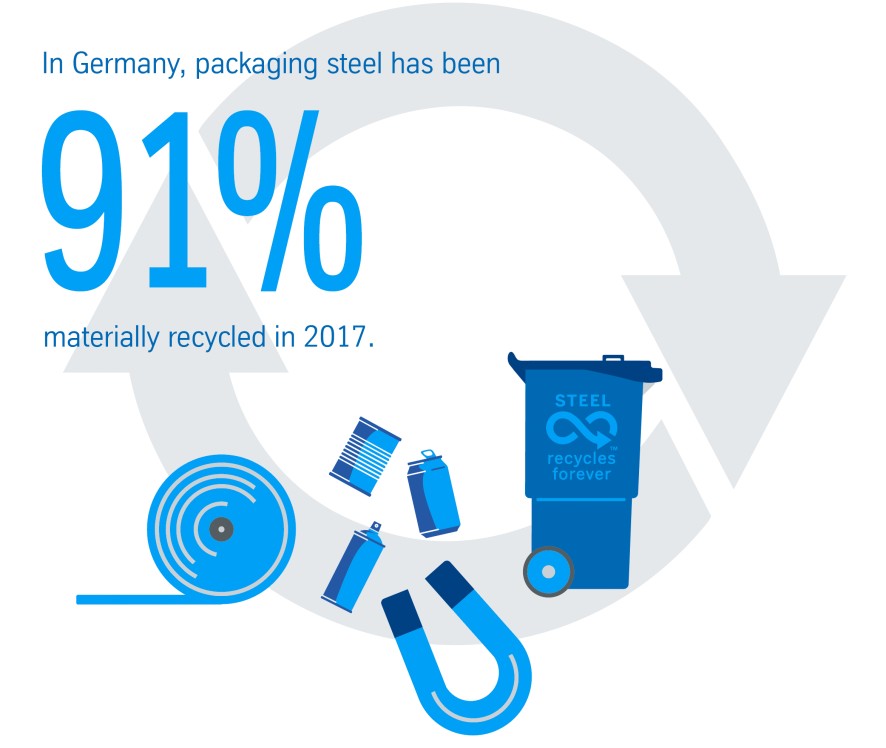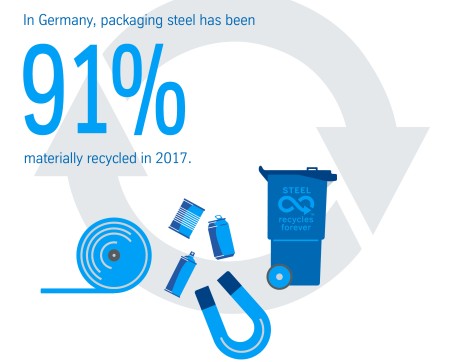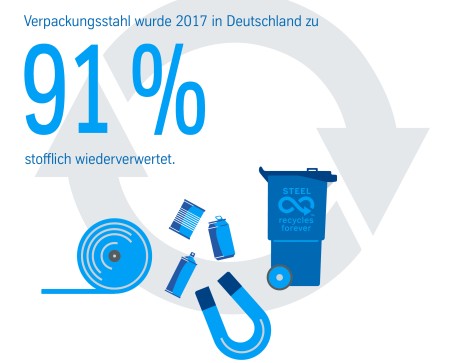Trade press, 2018-12-05, 04:54 pm
Material loop works: Recycling rate of tinplate remains high at 91 percent

91 percent of used tinplate packaging was materially recycled in Germany in 2017. In this year's recycling results for packaging, the recycling rate for tinplate is again well ahead of the rate for all other packaging materials and has stabilized at a high level. This finding was published by the gvm (Gesellschaft für Verpackungsmarktforschung) in their annual “Recycling Balance Sheet for Packaging”.
In the age of microplastics, tinplate is a good alternative
The great advantage of tinplate as a material is becoming increasingly obvious in terms of circular economy. Used steel packaging is collected by the dual systems, sorted without any problems, processed and sent for high-quality recycling as quality scrap. In concrete terms, this means that a certain amount of steel scrap is used in every steel mill to produce crude steel. The material cycle is thus a continuous loop.
“In times of great debate about microplastics, one of the biggest challenges is to promote the use of recyclable packaging materials,” explains Dr. Peter Biele, CEO of thyssenkrupp Rasselstein GmbH. “Millions of tons of plastic waste are already floating around in our oceans all over the world and becoming part of our food chains. By contrast, the high degree of recyclability of tinplate tells a completely different story.”
Since the foundation of the DWR (Deutsche Gesellschaft für Weißblechrecycling mbH) and its involvement in the non-profit company Kreislaufsystem Blechverpackungen Stahl GmbH (KBS), thyssenkrupp Rasselstein GmbH has actively contributed to the recycling of both privately-consumed tinplate packaging and commercially-produced quantities for many decades, ensuring that it is fed back into steel production in a professional and targeted manner.
Consumers can contribute to recycling efforts
Even though the recycling rate for tinplate rose by seven percentage points between 2005 and 2017, there is still room for improvement. “To further increase the recycling rate achieved in 2017, the cans, which today still end up in waste incineration after being wrongly thrown in with general waste, would also have to be integrated into the dual collection systems,” says Andreas Knein, Managing Director of DWR. “For this objective to be achieved, all those involved – from manufacturers to retailers, and dual systems to the recycling industry – must inform the public even more effectively. After all, recycling couldn't be any easier than with tinplate, as it’s a magnetic packaging material that is almost 100 percent recyclable.”
About us:
In Andernach, Rhineland-Palatinate, thyssenkrupp produces approximately 1.5 million tons of packaging steel each year. In this largest location of its type worldwide, thyssenkrupp rolls steel to an extremely thin 0.100 mm thickness and finishes the surface with tin or chrome. Nearly all of the company's output is shipped to packaging producers around the world. In addition to cans for food and pet food, packaging steel is used for beverage and aerosol cans, containers for chemical and technical goods, as well as crown corks and twist-off closures. thyssenkrupp employs approximately 2,400 people in Andernach.
Company blog:






